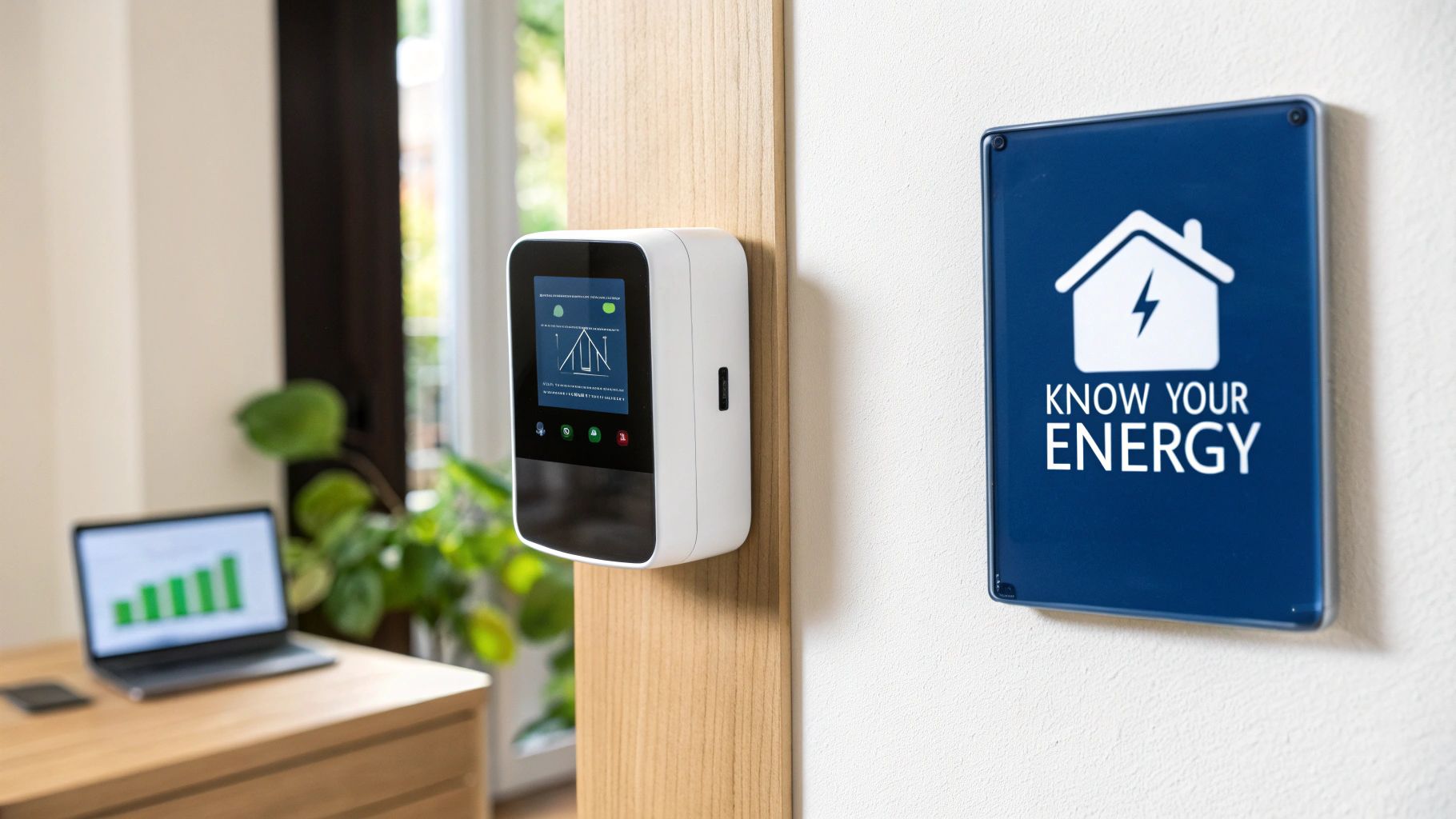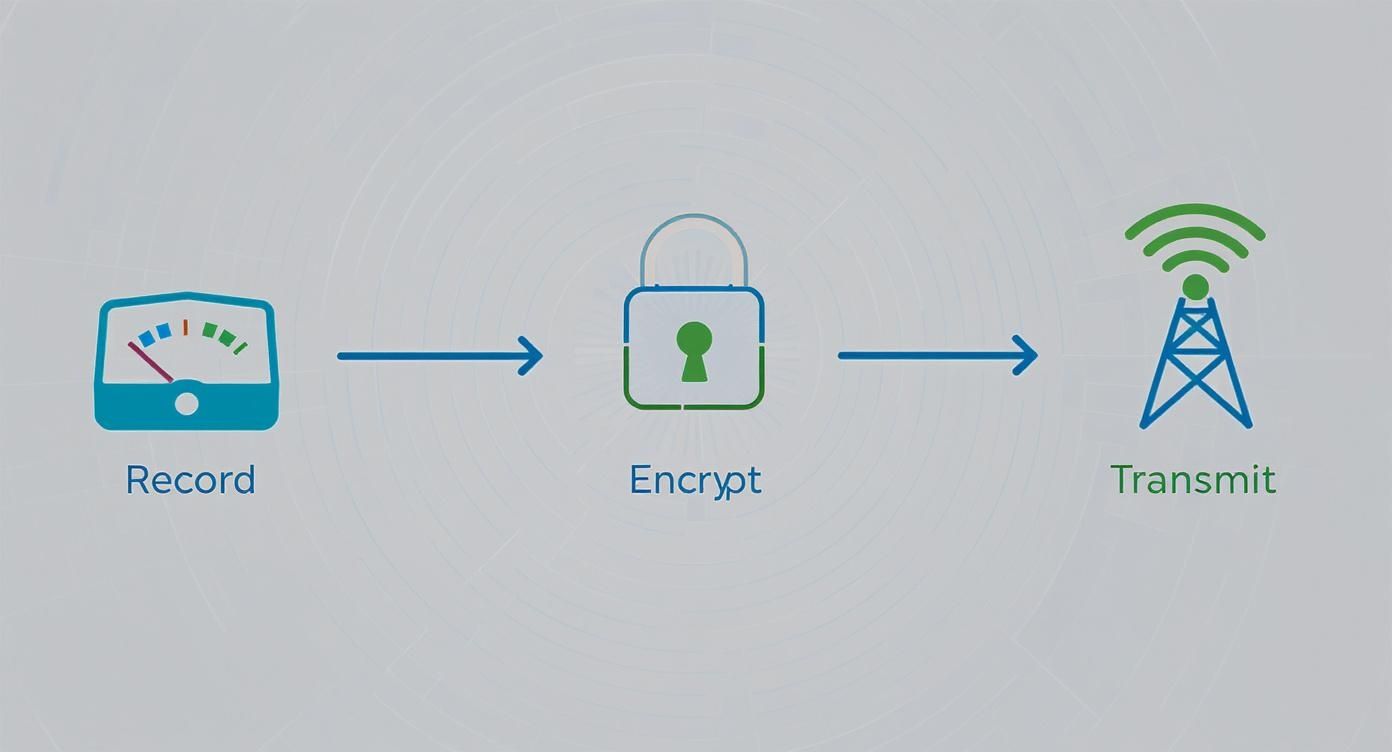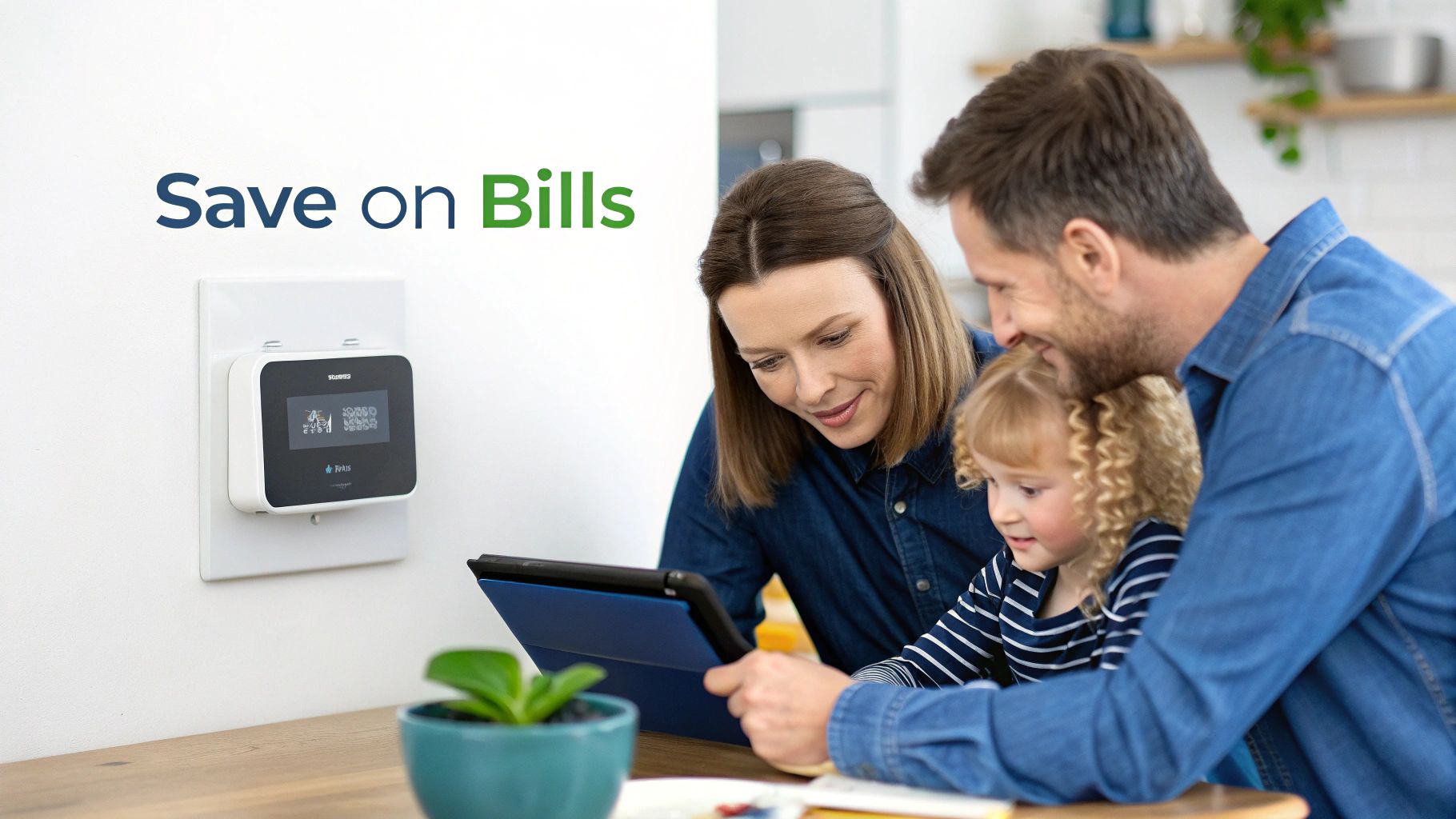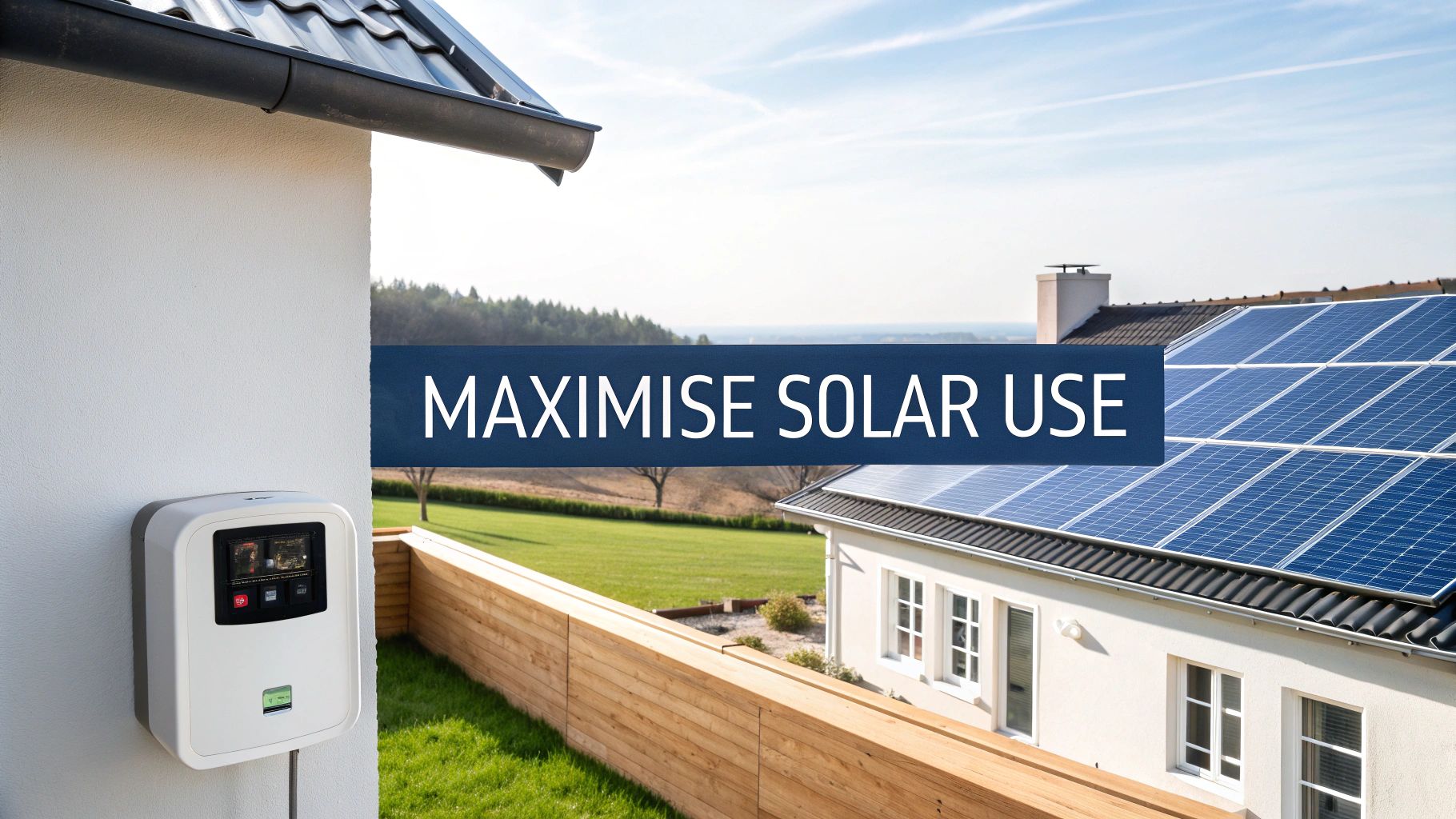What Is a Smart Meter and How Does It Work?
So, what exactly is a smart meter? Put simply, it’s the modern, digital upgrade to that old spinning-disc electricity meter you might have on the side of your house.
Think of it like swapping your old landline for a smartphone. It doesn’t just do one basic job; it opens up two-way communication between your home and your energy provider, sending them your exact usage data automatically and securely.
Understanding Your New Energy Hub

Let's cut through the tech-speak. Your old meter was a bit like a bucket that just tallied up your total power use over a month or a quarter. A smart meter, on the other hand, is an active participant in managing your home's energy. It’s a communication hub that completely changes how you see and pay for electricity.
Gone are the days of a technician traipsing onto your property to read the dials. The smart meter does that job digitally, which means the end of estimated bills. You finally get to pay for the precise amount of energy you actually used.
The Three Core Functions Of a Smart Meter
At its heart, a smart meter has three crucial jobs that give you more power as a homeowner and help modernise the entire grid:
- Automated and Precise Readings: It captures your electricity usage in tiny intervals, usually every 15 to 30 minutes, and sends this data straight to your retailer. No more guesswork, no more bill shock.
- Real-Time Energy Insights: By tracking your consumption patterns throughout the day, it gives you a clear picture of when and how you use energy. This is gold. You can finally pinpoint which appliances are chewing through power and make smarter choices to cut your costs.
- Access to Modern Energy Plans: This detailed data is the key that unlocks flexible, modern electricity tariffs like time-of-use pricing. These plans let you save money by shifting your energy use to off-peak hours when power is much cheaper.
By providing this constant stream of accurate information, a smart meter moves you from being a passive bill-payer to an active manager of your household's energy budget.
To give you a clearer picture, here’s a quick rundown of the key differences.
Traditional Meter vs Smart Meter at a Glance
This table breaks down the fundamental shift in technology and capability.
| Feature | Traditional Meter | Smart Meter |
|---|---|---|
| Data Reading | Manual, periodic reading | Automated, frequent reading (e.g., every 15-30 mins) |
| Communication | One-way (just records usage) | Two-way (sends and receives data) |
| Billing | Often based on estimates, quarterly reads | Based on actual, precise usage |
| Energy Insights | None | Detailed data on when and how you use power |
| Tariff Access | Limited to flat-rate plans | Unlocks time-of-use and flexible pricing |
| Outage Detection | Relies on customer reports | Can automatically notify the provider of an outage |
As you can see, it's not just a minor upgrade; it's a completely different approach to energy management.
Ultimately, understanding what is a smart meter comes down to seeing it as the foundational tech that connects your home to a smarter, more efficient, and more responsive energy grid. It's the essential first step for anyone with solar and batteries looking to get the most out of their system.
How Your Smart Meter Talks to the Grid
So, how does the information about your power usage get from the meter box on your wall to your energy provider? It's not the old-school way of someone walking up to read the dials. Think of a smart meter as a dedicated, digital messenger, creating a constant and secure conversation about your energy use.
The whole process starts with the meter itself, which meticulously tracks your home's electricity consumption. But instead of just one big number for the month, it takes a snapshot every 15 to 30 minutes. It’s this incredibly detailed, granular data that unlocks a much smarter way to manage your household's energy.
Before sending that information anywhere, each little packet of data is encrypted for security. This is a critical step. It ensures your personal energy information stays private and protected, using security protocols much like the ones your bank uses for online transactions.
The Journey from Your Home to the Network
Once the data is recorded and locked down, it needs to get to your energy retailer. This is handled by a dedicated and secure wireless network, similar to a mobile phone network but built specifically for the energy grid.
This communication happens automatically in the background, without you having to do a thing. The network whisks your usage data to a central data collection point, which then forwards it to your retailer for billing and analysis. The entire system is built to be reliable, secure, and completely hands-off for you.
This frequent, detailed data is what lets you see exactly when you use the most power. If you want to get a better handle on what the meter itself is showing you, take a look at our guide on how to read your electric meter for some practical tips.
This constant two-way conversation between your home and the grid is what makes a smart meter ‘smart’. It replaces a one-time, manual reading with a dynamic, ongoing digital relationship that benefits both you and the energy network.
Australia's Smart Meter Rollout Is Already Mature
This isn't some futuristic tech; it's already the standard across the country. In Australia, the smart meter rollout was initially led by retailers, but recent rule changes have made deployment a firm requirement. As a result, Australia’s smart meter saturation is now so high that the country is considered a mature market—we're already moving into installing the second generation of these devices. You can read more about the Asia-Pacific smart metering landscape on Business Wire.
Having this digital backbone provides a few key advantages:
- Faster Outage Detection: The network can instantly flag a power outage, letting crews know exactly where the problem is and respond much faster.
- No More Estimated Bills: Your bills are always based on what you actually used, right down to the minute.
- Enables Smart Tariffs: It opens the door to time-of-use energy plans that can reward you for shifting your power usage to cheaper, off-peak times.
Ultimately, this communication network is the unseen engine that makes modern energy management possible. It’s what gives you the information and tools to tweak your habits for real, tangible savings.
Why Australia Is Embracing Smart Grid Technology
The rollout of smart meters across the country is about far more than just your individual home. It’s the groundwork for building a stronger, more reliable, and future-ready energy grid for all of Australia.
Let's be honest, our traditional grid is facing some serious challenges. It's dealing with ageing infrastructure and the ever-increasing power demands of a growing nation. Smart meters are the critical building blocks for the modern solution: a smart grid.
This isn't just a simple upgrade of poles and wires; it's an intelligent, responsive network. It can actively manage the flow of energy, helping to prevent the kind of widespread blackouts we dread during summer heatwaves when every air conditioner is running flat out. This two-way conversation allows the grid to get ahead of problems instead of just reacting to them.
The infographic below shows how your energy data is transmitted securely and simply.

It’s this automated, encrypted flow of information that makes a smarter, more nimble national energy network possible.
Building a More Resilient Energy Future
One of the biggest wins for a smart grid is its ability to seamlessly weave in renewable energy sources like wind and solar. Old-school grids really struggle with the fluctuating nature of renewables, but a smart grid uses real-time data to balance supply and demand on the fly. When your solar panels are pumping out excess power on a sunny afternoon, the grid can instantly direct it to where it's needed most.
This shift is fundamental to Australia’s goals for energy independence and sustainability. The money being poured into this tech shows it's a major national priority.
Think of it this way: a smart grid turns our energy network from a one-way street into a dynamic, multi-lane highway. It allows clean energy to merge smoothly, prevents traffic jams during peak hours, and ensures a more reliable journey for everyone.
This push is backed by some serious market momentum and government support. Australia's smart meter market hit USD 1.1 billion in 2024 and is forecast to climb to USD 3.9 billion by 2033. What’s driving this? Rising electricity demand, plus a big nudge from the Australian Energy Market Commission, which is fast-tracking the rollout to get a smart meter into every Aussie home by 2030. You can dig into the numbers and market drivers in this detailed industry report on openpr.com.
Ultimately, when we understand what is a smart meter, we see it’s not just a gadget. It’s a key piece in creating a national energy system that’s more efficient, more resilient, and ready for whatever comes next.
What This Means for Your Household Budget

It's one thing to understand the tech, but how does a smart meter actually help your wallet? The benefits are practical and immediate. You go from being a passive bill-payer to someone who can actively manage your home's energy.
It’s all about having the right information when you need it.
The biggest change is the end of estimated bills. No more nasty surprises based on a retailer’s guesswork from last year. With a smart meter, your bill reflects exactly what you used, giving you a clear, accurate picture of your costs.
This detail is powerful. It lets you finally see the real-world impact of your daily habits and make smarter financial decisions.
Pinpoint Energy Waste and Save Money
Ever wondered which appliance is the secret energy hog in your home? A smart meter’s near-real-time data is like a spotlight, helping you hunt down those power-hungry devices. You might discover that the old spare fridge in the garage is costing you a small fortune each quarter.
This insight allows you to take targeted action. Smart meters give you the granular data to really understand your consumption, including how to calculate a Kilowatt Hour and what that means for your bottom line.
Armed with this knowledge, you can make informed choices, like upgrading an inefficient appliance or shifting a few habits, and then actually see the savings on your next bill. If you're keen to find more ways to trim your costs, our guide on how to reduce electricity bills has plenty of practical tips.
A smart meter transforms your energy data from a mysterious number on a bill into a powerful tool for financial management. It’s the difference between guessing where your money is going and knowing exactly.
Unlock Smarter, Cheaper Energy Tariffs
Perhaps the most potent financial benefit is gaining access to flexible energy plans, often called ‘time-of-use’ tariffs. These plans charge different rates for electricity depending on the time of day. Power is cheapest during off-peak hours (like the middle of the night) and most expensive during peak demand (like weekday evenings).
Without a smart meter, these plans are impossible. With one, you can strategically shift your energy use to save money:
- Run the dishwasher or washing machine overnight when electricity is cheap.
- Charge your electric vehicle during those off-peak windows.
- Avoid using major appliances during the expensive evening peak.
This ability to monitor and react has become vital as Aussies face rising electricity prices. Smart meters are dominating the market for a simple reason: they let people see their usage in real time, enabling them to make choices that directly lower their energy spend.
By taking control of when you use power, you can significantly reduce your overall energy costs.
Unlocking the Full Potential of Your Solar and Battery

If you've got solar panels and a battery, a smart meter is far more than just a tool for your energy retailer to bill you. Think of it as the central nervous system for your home’s energy. It’s the key piece that transforms your setup from a passive power user into an active, intelligent player in the energy market.
Without a smart meter, your solar and battery system is essentially flying blind. Sure, it can power your home and store leftover energy, but it’s stuck in its own little bubble. It has no way to strategically work with the grid to really squeeze every drop of value from your investment. A smart meter closes that gap, feeding your system a constant stream of precise energy data.
This live information is what allows your system to start making smart, automated decisions that actively save and earn you money.
Maximise Your Solar Self-Consumption
The whole point of getting solar is to use as much of your own clean power as possible. This is what we call self-consumption. A smart meter provides the real-time data needed to nail this with incredible efficiency. It knows exactly how much power your panels are making and how much your home is using, right now.
This allows a smart platform like HighFlow Connect to send that energy where it’s most valuable. For instance, instead of exporting your solar power for a pittance in the middle of the day, the system can automatically send it to charge your home battery, saving it for when you really need it later.
A smart meter acts like an air traffic controller for your home's energy. It makes sure every kilowatt of solar power is directed to the most valuable destination—whether that's running your appliances, filling your battery, or being sold to the grid at the best possible price.
Intelligent Charging and Discharging Strategies
Your battery becomes a much more powerful tool when it’s connected to smart meter data. It’s no longer just a backup for blackouts; it becomes a financial asset. The meter's data lets your system analyse grid pricing in real-time and make calculated moves.
Smart meters are what enable households to connect to smart tariffs and get the most out of advanced battery systems. You can see this synergy in action with setups like Octopus Agile and Givenergy battery storage solutions.
This strategic approach unlocks a few powerful plays:
- Grid Charging: When grid electricity is dirt cheap overnight (sometimes even free!), your system can automatically top up your battery. You then use that cheap stored energy during the expensive evening peak.
- Profitable Exporting: The system knows when wholesale energy prices are spiking. That’s its cue to discharge your stored solar energy back to the grid, earning you a premium rate instead of the flat feed-in tariff.
This dynamic management means you’re always buying low and selling high, effectively turning your home into a tiny, profitable power station. This level of control is fundamental to getting the best return on your investment and is a core part of what makes joining a Virtual Power Plant (VPP) so rewarding.
How Smart Meters Plug You Into a Virtual Power Plant
If you have solar panels and a home battery, your smart meter is doing more than just counting kilowatt-hours. It’s the key that unlocks something bigger: the **Virtual Power Plant (VPP)**. This is where your home stops being just a power *user* and starts actively supporting the entire grid.
Think of a VPP as a neighbourhood energy co-op, but on a massive scale. It links hundreds, sometimes thousands, of individual home batteries into a single, coordinated resource. Your smart meter is the communications hub in this network, feeding back the real-time data that makes the whole thing work.
This constant, two-way conversation lets a VPP operator like HighFlow Connect see what’s happening across the grid in real-time. The smart meter reports when your battery is full and your home’s demand is low, signalling that you’ve got spare energy ready to share.
Coordinating Energy When the Grid Needs It Most
When the electricity grid is under stress—say, on a scorching summer afternoon when every air conditioner is running flat out—it needs extra power, and fast. This is where the VPP springs into action.
Using the data from your smart meter, the VPP operator sends a signal to your battery, asking it to discharge a small amount of stored energy back to the grid. When your battery does this in sync with hundreds of others, the combined effect is powerful. It’s like a traditional power plant firing up, but it’s cleaner, faster, and spread across the community.
You can dive deeper into how this works in our detailed guide on what is a Virtual Power Plant.
This rapid response helps stabilise the grid, prevent blackouts, and cuts down the need for expensive, dirty "peaker" plants that run on fossil fuels.
By joining a VPP, your home battery becomes part of a larger, intelligent system. Your smart meter is the crucial link that lets you contribute to a more resilient grid and get paid for it.
This isn’t just about helping out the community; it’s one of the best ways to get the most financial value out of your solar and battery investment. You earn payments for the energy you send back, right on top of the savings you’re already making on your power bills.
For homeowners, participating in a VPP delivers a few key wins:
- Earn Extra Income: You get paid for exporting your stored energy during high-demand events.
- Support Renewables: By helping to balance the grid, your battery allows more solar and wind power to be used across the network.
- Strengthen the Grid: You become part of a community-led solution that improves energy reliability for everyone.
At the end of the day, that small box on the side of your house—your smart meter—is what connects your home to this modern energy community.
Answering Your Smart Meter Questions
New technology always brings a few questions. It’s only natural. Let's tackle some of the common ones Australian homeowners ask when a smart meter is on the cards.
Are Smart Meters Compulsory in Australia?
Pretty much, yes. They are now the standard for any new home or whenever an old meter needs replacing.
While no one will force an upgrade if your old spinning-disc meter is working fine, the goal is to have smart meters in every Aussie home by 2030. So, when your current meter eventually fails or just gets too old, its replacement will be a smart one.
Is My Personal Data Secure?
Absolutely. Keeping your data safe is baked into the design.
Your energy usage data is protected with the same kind of heavy-duty encryption your bank uses. On top of that, strict Australian energy and privacy laws dictate exactly how your data can be used. It’s strictly for billing and helping manage the grid—that’s it.
Think of it this way: your smart meter knows how much power you're using, but not how you're using it. It can't tell if you're running the dishwasher or binge-watching Netflix. Your privacy is protected by robust encryption and national regulations.
Do I Have to Pay for a Smart Meter Installation?
You generally won't get a big, upfront bill for a standard installation.
The cost is typically rolled into the network charges on your electricity bill over time. It's a bit like how the maintenance for the poles and wires in your street is covered.
The only time you might see a direct fee is if you request a special upgrade outside of the normal schedule. It’s always a good idea to check with your energy retailer first, just so there are no surprises.
Ready to put your smart meter to work? With HighFlow Connect, it becomes the key to earning more from your solar and battery and helping build a more stable, cleaner grid. Discover how our VPP can work for you.


